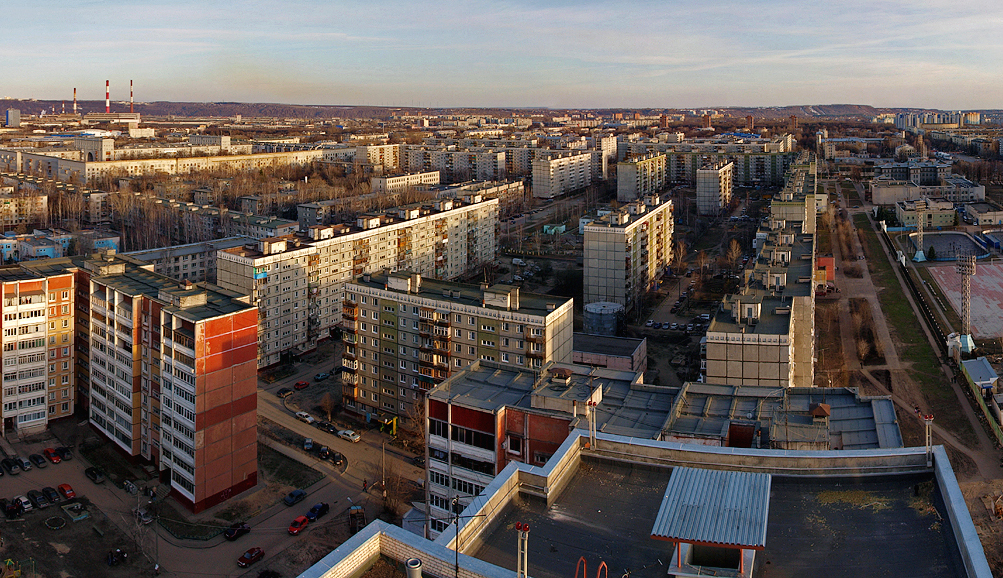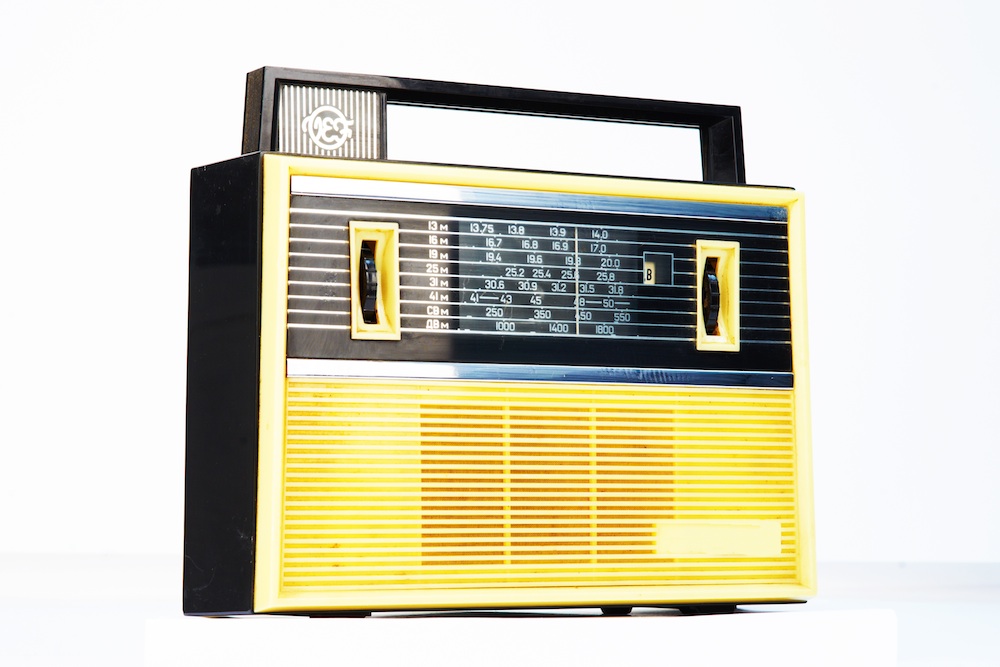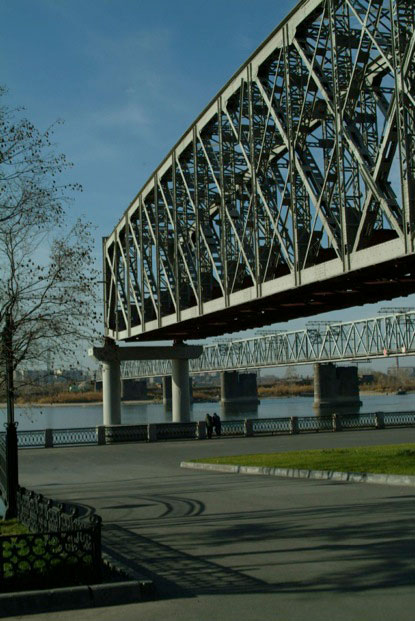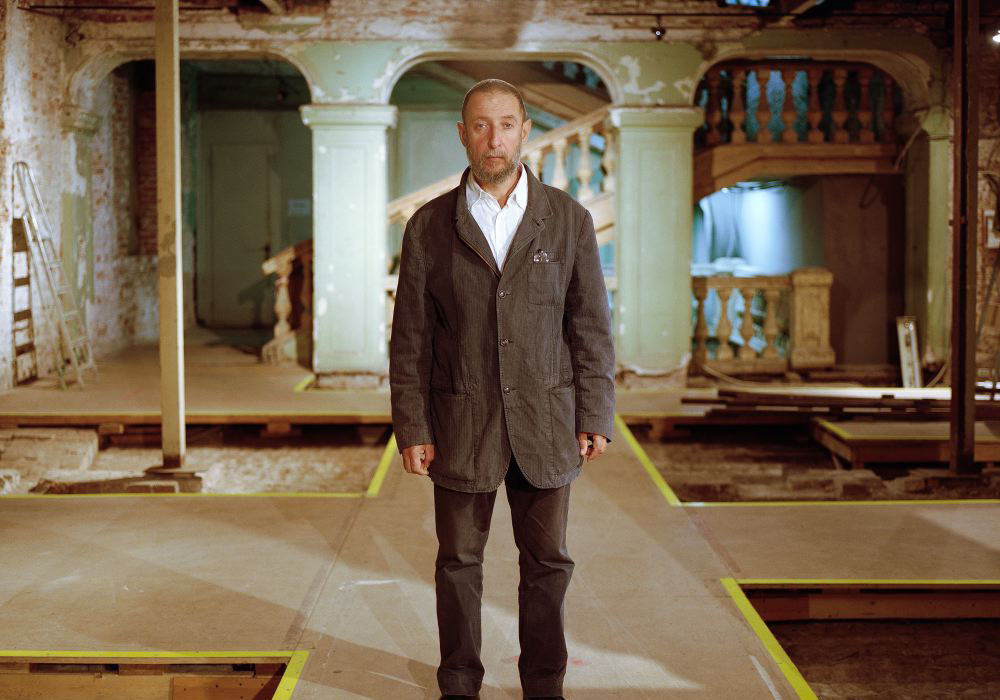Addressing the past: Moscow’s crowd-funded memorials to victims of Soviet repression
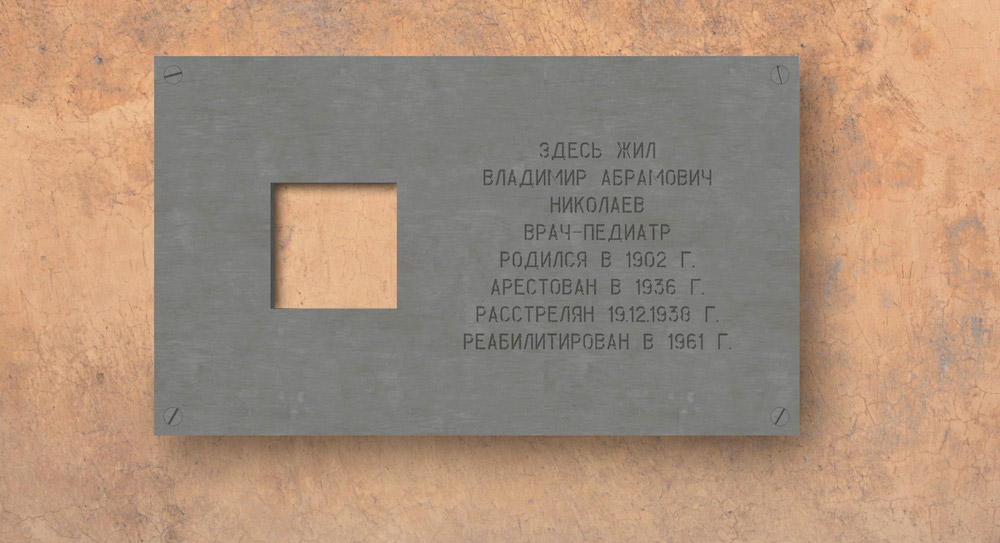
As the Russian state pushes a nationalist ideology, it's an inauspicious time to remember those who died in some of the country's darkest times. But a group of volunteers in Moscow is taking things into its own hands
Historian Nikita Sokolov opposes the whitewashing of Russia’s history. He’s written articles and spoken on the radio. And last week, he defended his beliefs with a power drill.
With snowflakes powdering his scruffy knit cap, Sokolov climbed a stepladder in smoggy central Moscow and hung two rectangular, silvery grey plaques no bigger than a man’s hand on the wall of a massive Stalin-era apartment block at 5 Dolgorukovskaya Street. His fellow traveller Serguei Parkhomenko, a well-known journalist, dragged the ladder over a few feet and put up two more signs.
Designed by the eminent architect-artist Alexander Brodsky, each plaque bears eight lines of chiselled text, with the same formula, just different names, professions and dates: “HERE LIVED RAISA LEONIDOVNA KHAVINA-SKRYPNIK; ENGINEER; BORN IN 1904; ARRESTED 11.07.1938; EXECUTED BY SHOOTING 28.08.1938; REHABILITATED IN 1990.” To the left of the text, a square has been cut in the metal — like the hole that replaced the person, one of the millions of Soviet citizens taken from their families without warning and executed or jailed without a fair trial. “The only way to preserve the memory of the victims — not with some pompous monument intended for formal rituals on specially designated days, but with an everyday, intimate reminder about responsibility — is to find a personal space for them within the modern city,” Sokolov wrote a day earlier in Ezhednevny Zhurnal, an online magazine (blocked in Russia).
“The topic of repressions and masses of victims doesn’t really fit in with this ‘country of victories’”
The commemorative signs, among the first batch of 18 to go up in Moscow this month, are part of The Last Address, a volunteer-driven, crowd-funded effort started by Parkhomenko a year ago to memorialise victims of Soviet-era political repression and arbitrary rule. Inspired by German artist Gunter Demnig’s project to honour victims of Nazism, The Last Address likewise marks the last places victims lived of their own volition. The idea comes at an inauspicious time for those who care to look critically at Russia’s past. In an atmosphere of growing antagonism with the west, and a haemorrhaging economy at home, Moscow has been touting a conservative, nationalist ideology that has been quick to see enemies all around, while glorifying the country’s uniqueness, traditions and historic victories.
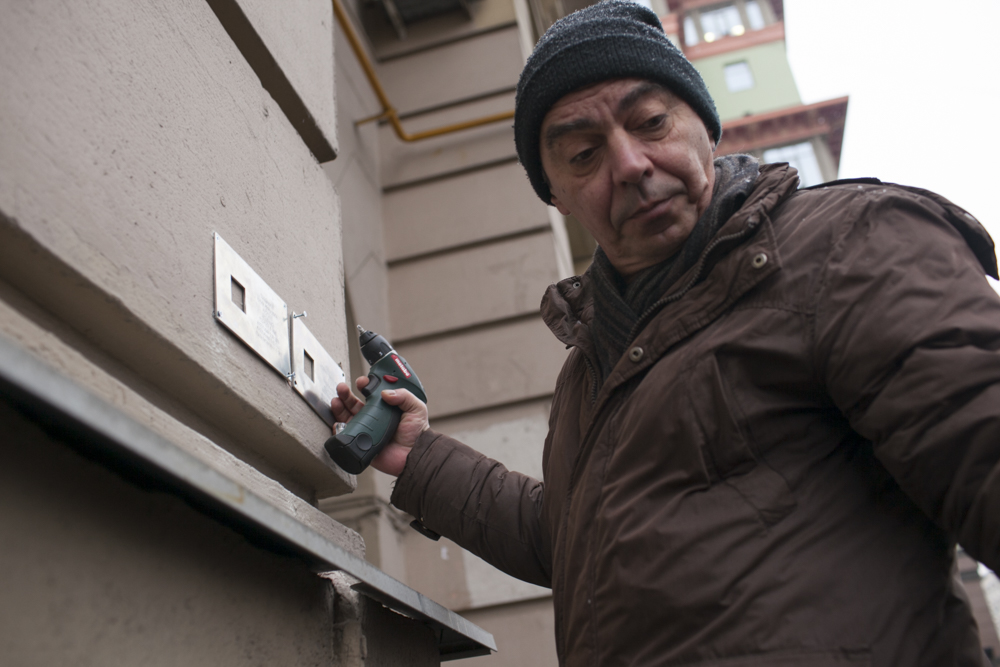
“The topic of repressions and masses of victims and so forth doesn’t really fit in with this ‘country of victories’”, says Elena Zhemkova, executive director of the International Memorial Society, a research and human rights group that has spent over 20 years documenting the injustices of the Soviet repressive apparatus, and has faced a number of legal and public-relations attacks from the state in the past two years.
Though the topic of political prisoners began shedding its taboo status in the late 1980s, Russian society has not got very far in coming to terms with what happened. Zhemkova faults a lack of government effort and a reluctance to speak about accountability. Repressions are viewed as a natural disaster of sorts, “like the plague in the Middle Ages”. “They’re not described as state-run terror; people don’t talk about their roots or who’s to blame,” she said. “And, of course, people don’t talk about what needs to be done for this not to happen again. That’s the problem.”
Although talk of the Great Terror is by no means forbidden, Russians do not see Stalin as an unequivocal villain
Another obstacle to genuine reckoning is haziness: the Soviet Union’s program of exterminating its citizens — unlike Germany’s under the Nazis — didn’t draw such a stark line between executioners and victims. The former inhabitants of 5 Dolgorukovskaya Street serve as perfect examples, according to Dmitry Belanovsky, a resident and amateur historian of the building: an arrested diplomat died in prison in 1938; by spring 1940, the secret-police captain in charge of his case was executed as an enemy of the people; then that officer’s family had to share a flat with the wife and sons of a freshly arrested trade official.
As Sokolov and Parkhomenko put up the small signs, a crowd of about 70 people watched, a majority with grey hair. One woman crossed herself and mumbled a prayer; another handed out crimson carnations that her neighbours laid on a dingy tin ledge. The arrest dates on three of the four plaques fall between 1936 and 1938, the years of the most notorious and wide-scale arrests, known as Stalin’s Purges or the Great Terror. The Last Address, however, strives to cover the entire Soviet period, from 1917 to 1991.
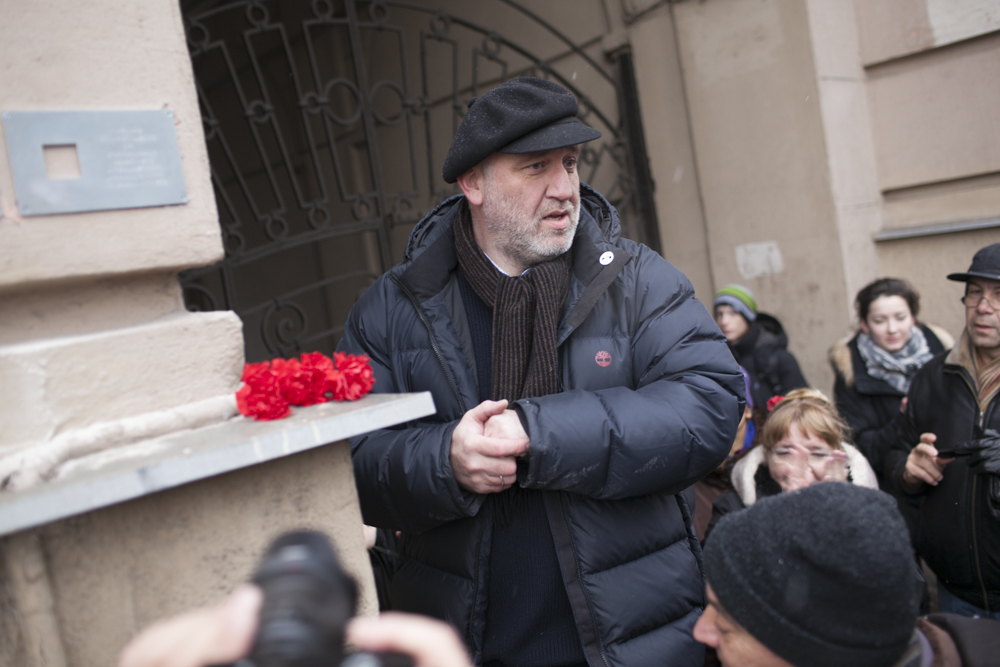
Although talk of the Great Terror is by no means forbidden — on the contrary, the state-funded gulag museum is set to move next year into a four-storey space nearly ten times its current size — Russians do not see Stalin as an unequivocal villain. Fifty-one years after the tyrant’s death, he is broadly credited with the Soviet victory in the Second World War, which retains immense significance here, and often admired as an “effective manager,” responsible for major accomplishments like industrialisation and law and order.
Those attitudes have been perpetuated by President Vladimir Putin, a career KGB officer until the Soviet collapse, who has led the country for the past 15 years. His criticism of Stalin has been laced with praise, and his brand of state-backed patriotism has sought to stigmatise dissenters as enemies and to stymie intellectual debate, while reinforcing select images of Russia’s greatness. According to Memorial’s figures, the number of political prisoners arrested during Stalin’s lifetime alone was around 11 million. But a survey released this fall by a Kremlin-friendly pollster showed that the proportion of Russians who believe there were no mass political repressions in the USSR has doubled over the past 13 years, from 8% to 16%.
“If there are two or three thousand of these signs hanging across Moscow, it will be very noticeable”
The paradoxes in Russia’s views of its past crop up often in the capital’s landscape. Take the monument to Felix Dzerzhinsky, founding father of the Soviet secret police, which once stood outside KGB headquarters. Its jubilant toppling in 1991 became an iconic image symbolising the fall of communism; it seemed at the time like a perfect metaphor for Russians’ rejection and condemnation of their repressive government. But Moscow’s city legislature perennially considers motions to re-erect the statue. And a few blocks from the empty mound where it stood, a three-storey, pre-revolutionary building with Italianate curlicues still bears an enormous plaque solemnly identifying it as Dzerzhinsky’s one-time workplace; yet it offers nothing to commemorate the several thousand purge victims shot dead in its fenced-off courtyard and specially designated rooms, their walls lined with wood planks to mute the sound of gunshots.
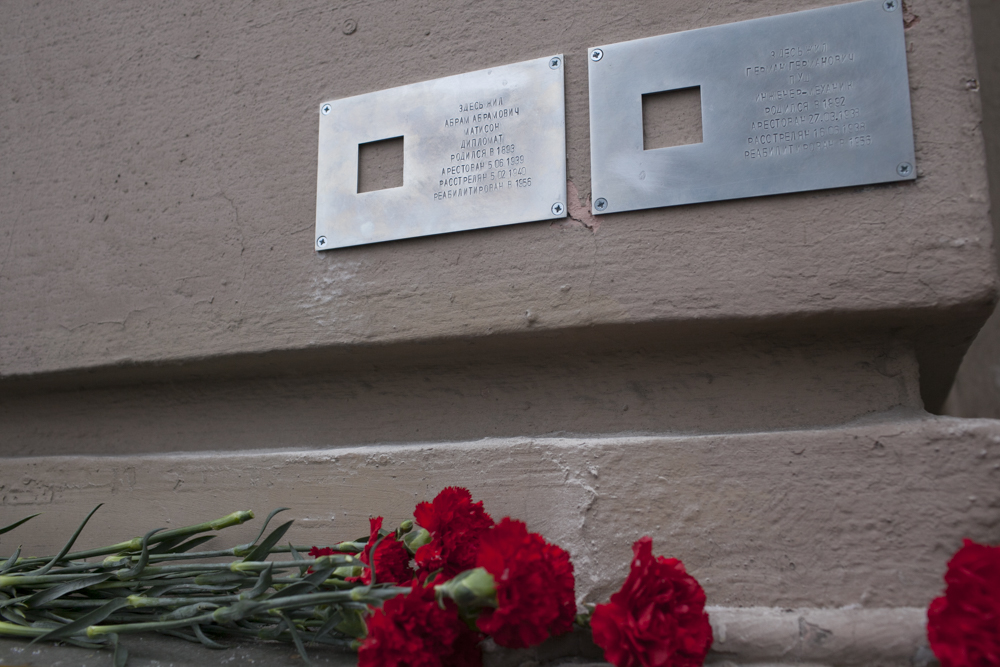
The Last Address intends to shift the balance a bit. “If there are two or three thousand of these signs hanging across Moscow, it will be very noticeable,” Parkhomenko told me over coffee a few weeks before the first plaques went up. “It will be noticeable enough for people to walk past on the streets and wonder, ‘What is that?’ Children will ask, ‘What is that?’”
Like the German project that inspired it — called Stolpersteine, or “stumbling blocks,” which now number around 45,000 across a dozen countries — The Last Address relies on two basic principles: one name per sign, and one concrete individual “initiating” each plaque. The initiator must pay the production cost: 4,000 roubles per sign, which has plummeted with the exchange rate this year from about $120 to below $70. So far, more than 300 applications have come in. The primary source for addresses is Memorial’s database, which includes some 2,650,000 Soviet victims of political repression (though far, far fewer addresses). Because of Moscow’s climate and penchant for destructive construction work, the plaques, unlike their German counterparts, are going on walls instead of sidewalks; because of periodic waves of scrap-metal theft, pricey brass has been substituted with zinc-coated steel.
The Last Address has received no government support, but raised nearly 1.5 million roubles through online crowd-funding, and Parkhomenko says that all he wants from officials “is that they not interfere” with the plaques, that no “guy shows up with a crowbar, shouting ‘It’s not allowed!’, and starts prying them off”.
“Everyone finds his own reasons to love his country,” Parkhomenko said. “Some love it because it had an ‘effective manager’ who cold-bloodedly killed off many millions of people… I’m going to love and respect my country for remembering each and every one of those millions.”
